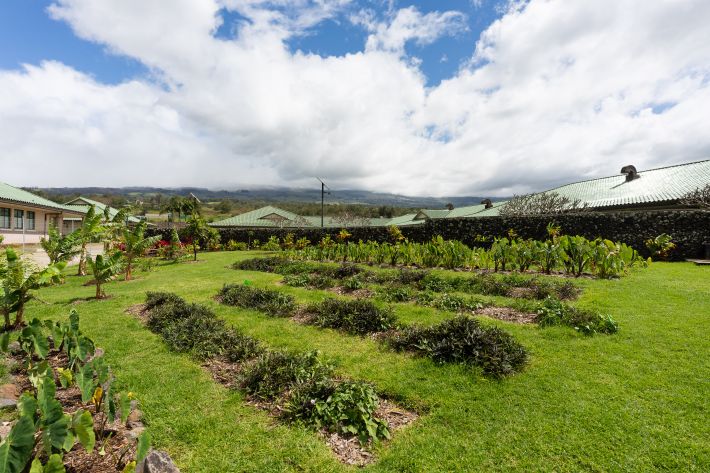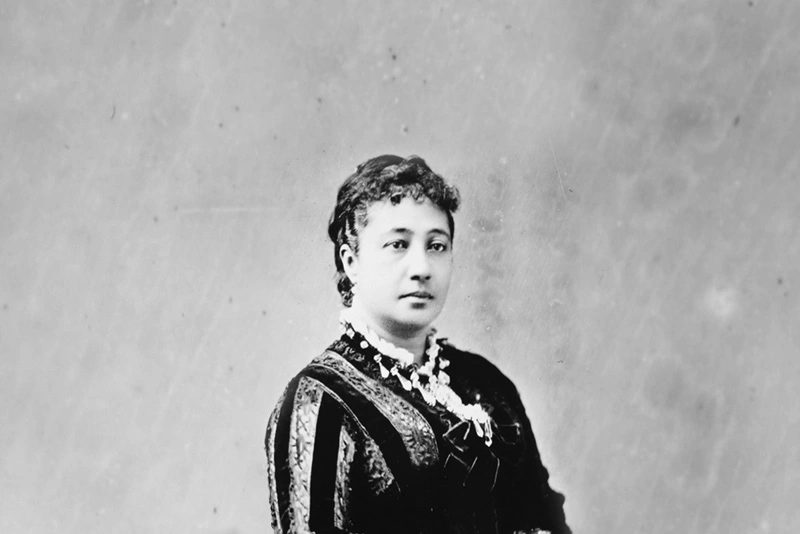Moss Kuon KSM’28 is always ready to roll up his sleeves when it’s time to work in the middle school māla at Kamehameha Schools Maui, named Hānaiaulu. Together with his classmates, they venture on this spring morning to the lush ʻAʻapueo hillside to learn how to husk a coconut and prepare coconut milk, something many have never done before.
“It makes me happy to see people connecting with Hawaiian culture by making food because a lot of what people eat, they don't see where it comes from,” Kuon said.
He admits that he didn’t know how to prepare Hawaiian foods until the Kupa ʻĀina Elementary Science Program started at his school. Led by longtime farmer and ‘āina & sustainability learning designer Hōkūao Pellegrino, this initiative teaches science through an ʻāina-based lens and empowers haumāna to be pono environmental stewards. Central to the curriculum is the cultivation of native crops on campus and participation in their farm-to-school program, Nā ʻOno o ka ʻĀina.
At Kamehameha Schools, where campuses serve thousands of meals daily, sustainable food practices take center stage. For strategy consultant Leanne Kami, that means increasing the amount of locally grown foods across campuses through institutional purchasing.
“We can make a huge impact, not only on our health and economy but also on the ecology of Hawaiʻi. Our food choices play a huge role in all those sectors,” Kami said.

Known for its healing and medicinal properties, māmaki is an endemic plant of Hawai‘i.
Since 2020, KS campuses have seen significant increases, with most serving around 45% locally grown food. In contrast, a 2022 report by the Department of Education showed that Hawaiʻi public schools served only 6% of locally grown and produced food. With a focus on sustaianble practices, KS Hawaiʻi serves ʻulu and kalo twice a month. Lunchtime poi has increased from once a year to every day at KS Kapālama. At KS Maui, they mill fresh poi twice a month. Furthermore, they integrate ʻulu, ʻuala and kalo from their māla into their dishes, while also harvesting māmaki for over a dozen gallons of tea monthly. By next year, the Maui campus plans to stop using imported potatoes within their meals and solely incorporate Hawaiian starches such as ‘ulu, kalo and ‘uala. Furthermore, they plan to source their ‘uala exclusively from their māla. The ahupuaʻa of ʻAʻapueo was historically known for the cultivation of the native sweet potato.
“One triumph of this effort is just bringing back the ‘ono,” Kami said. “We’ve really moved the needle in Native Hawaiian crops and getting people to eat them again.”
With leaders like Pellegrino intentionally connecting curriculum to their lunches, haumāna have deeper learning experiences, approaching traditional subjects with a Hawaiian perspective – a prime example of Hawaiian culture-based education.
From the time they are in elementary school, Maui students are growing their kilo skills and go on to learn traditional agroforestry in middle school. By the time they are high schoolers, they merge the two with a focus on upscaling production for their dining hall. Over their educational careers, not only are they learning more about food systems and agriculture but they are also learning about the innovative and sustainable land tenure practices of their ancestors and the kuleana they have as Hawaiians today to continue perpetuating this important way of life.
“Plants are an integral part of who we are as an indigenous people,” Pellegrino said. “Our ancestors carefully chose specific food crops and medicinal plants to bring with them across the Pacific not only to survive – but as a means to thrive. We wouldn’t be here without them.”
As they grow alongside their garden, Kuon says it’s rewarding how much their school’s māla has produced since his first time planting ʻulu in the sixth grade. Not only is it fun for the middle schooler to be outside but it enhances his worldview by deepening his cultural roots.
“There are so many things you learn here in the māla that you can apply anywhere else,” Kuon said. “Sometimes, you just have to put your hands in the ground and ʻāina will teach you.”

TAGS
maui campus,ks maui,food sustainability,ʻāina-based education,native hawaiian identity
CATEGORIES
Kaipuolono Article, Regions, Maui, Moloka’i and Lana’i, Themes, Culture, Community, KS Announcements, Maui Newsroom, KS Maui Home, Maui Elementary School, Newsroom, Maui, Oiwi Leaders, Maui campus
Print with photos
Print text only










